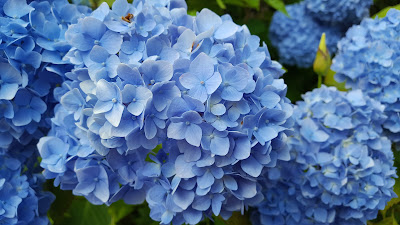 |
| What causes blue hydrangeas to turn pink? |
Out of all the hydrangeas available today perhaps the most popular with English gardeners are the macrophylla cultivars. Although they come in a variety of colours from rose-pink to white and even to a deep red, it is the almost cobalt-blue flowering forms that really capture the imagination.
 |
| What causes blue hydrangeas to turn pink? |
The easiest way to prevent this colour change from happening to your blue hydrangeas is to plant them directly into an ericaceous compost mix and then - if you are watering them in a hard water area - feed with an acidic food such as Miracid or Sequestrene.
In alkaline soils, plants from the Ericaceae family – of which the hydrangea is not a member - have difficulties in taking up iron and magnesium from the soil through the roots. This is typified by characteristic interveinal yellowing - known as chlorosis - as both iron and manganese are vital for the formation of chlorophyll pigments within the leaves.
This characteristic patterning shown by chlorosis is because the chlorophyll pigment found in the vascular bundles – the leaf veins – will remain unaffected for longer periods than chlorophyll pigment found in the cells between the vascular bundles. Also, because of the low mobility of iron within the plant and relatively higher concentrations within older leaves due to the formation of iron binding proteins, leaf discoloration is far more prevalent in the new, juvenile leaves found near to the growing points.
This will also be experienced in hydrangeas growing in alkaline soil and in extreme cases newly formed leaves can grow through almost pure white in colour.
 |
| Iron chlorosis on hydrangea |
This will also be experienced in hydrangeas growing in alkaline soil and in extreme cases newly formed leaves can grow through almost pure white in colour.
Although the modern gardener has various products with which they can help acidify the soil around the root ball to relieve this problem is was a different matter going back a century or so to the Victorian gardener. During the latter end of the 19th Century it was common practice for Victorian gardeners to plant their hydrangeas with a healthy mix of rusty nails or old horse shoes. Both of which were made from iron an essential ingredient for the soils nutritional balance. Later, dissolving a spoonful of Epsom salts in a watering can and pouring it around the root-ball became a popular method. So rather than fix the acidity problem, they instead over loaded the soil with the nutrients that the plants were struggling with.
Today, pink (but originally blue) hydrangeas can be treated by spraying the leaves with soluble iron foliar feeds every 2 - 4 weeks or by lowering the soil pH. This is achieved by applying chelates, ferrous sulphate, aluminium sulphate, or sulphur to the soil surface and allowing them to dissolve into the soil by watering and rainfall. At the very least, use soluble, acidic plant fertilisers such as Miracid or Sequestrene as a weekly liquid feed. Be aware though that it will take weeks and not days for the effects to show through.
For related articles click onto the following links:
CHANGING THE COLOR OF HYDRANGEAS
HOW TO GROW HYDRANGEA
HOW TO PRUNE HYDRANGEA
HOW TO TAKE HYDRANGEA CUTTINGS
WHICH ARE THE BEST BLUE-FLOWERING HYDRANGEAS?







No comments:
Post a Comment